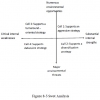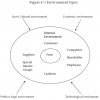Strategic Management - Environmental Analysis and Diagnosis
Environment and Strategic Analysis - Environmental Analysis
Posted On :
By the very principle of its operation, industry never reaches a point of equilibrium.
Environment and Strategic
Analysis
By the very principle of its operation, industry never reaches a point of equilibrium. Strategic analysis provides the framework on study, forecast, anticipates and prepares the organization to tackle the challenges posed by the changes, head on.
Organizations have to recognize the dynamic nature of the environment in which they operate. The environment is affected by a number of factors that include events and influences from a number of sources, resulting in a complex play of forces that are not easy to analyze in their totality.
Internal factors are those over which the business enterprise can exercise its control and are regarded as controllable variables. External environmental factors are regarded as uncontrollable factors. As the external factors of environment are beyond the control of a business enterprise, its progress, success and survival largely depends upon its capacity and ability to adapt successfully to environmental changes. In order to do this, it will have to reorganize, readjust its controllable internal factors to suit the external business environment.
Effective strategic management begins with assessment of business risk. Business risk arises as much from the likelihood that something good will not happen as it does from the threat that something bad will happen. Each organization has its own unique set of business risks and these risks keep changing constantly. Some risks are external, e.g. competitors, economic conditions, and capital availability etc. Others are internal, resulting from the company’s own organization, processes, products, and relationship with customers, shareholders, suppliers and employees; information; and contractual commitments.
There are two mainstreams of thought on strategy. These are represented by the ‘fit’ concept of the ‘positioning school’ and the ‘stretch’ concept of the resource based’ school. Each of these schools views strategy differently, as a result of which strategic capability is also viewed differently.
The traditional concept of organizational strategy is based on the ‘fit’ concept. This concept is propagated by the ‘positioning’ school and more particularly by Michael Porter in his development of the theory of competitive strategy. According to this, strategies should aim at achieving fit between environment and organizations.
Gary Hamel and C.K. Prahlad opined that the conventional framework of strategy using the ‘fit’ concept is incomplete as a strategy for the organization. Though the long-term strategy should have a consistency and purpose and supplement the idea of ‘fit’, the importance of competitive strategy is not about how the organization fits its strategy to match its resources, but about how the organization marshals its resources. They said, “competitiveness is born in the gap between a company’s resources and its managers goals. “The long term competitive success depends on managers’ willingness to continually challenge their existing frames of reference. Leveraging resources can do this. Leveraging resources is as important as allocating them. This concept of leveraging resources so as to extend the capabilities of the organization and its competitiveness is called ‘stretch’.
By the very principle of its operation, industry never reaches a point of equilibrium. Strategic analysis provides the framework on study, forecast, anticipates and prepares the organization to tackle the challenges posed by the changes, head on.
Organizations have to recognize the dynamic nature of the environment in which they operate. The environment is affected by a number of factors that include events and influences from a number of sources, resulting in a complex play of forces that are not easy to analyze in their totality.
Internal factors are those over which the business enterprise can exercise its control and are regarded as controllable variables. External environmental factors are regarded as uncontrollable factors. As the external factors of environment are beyond the control of a business enterprise, its progress, success and survival largely depends upon its capacity and ability to adapt successfully to environmental changes. In order to do this, it will have to reorganize, readjust its controllable internal factors to suit the external business environment.
Effective strategic management begins with assessment of business risk. Business risk arises as much from the likelihood that something good will not happen as it does from the threat that something bad will happen. Each organization has its own unique set of business risks and these risks keep changing constantly. Some risks are external, e.g. competitors, economic conditions, and capital availability etc. Others are internal, resulting from the company’s own organization, processes, products, and relationship with customers, shareholders, suppliers and employees; information; and contractual commitments.
There are two mainstreams of thought on strategy. These are represented by the ‘fit’ concept of the ‘positioning school’ and the ‘stretch’ concept of the resource based’ school. Each of these schools views strategy differently, as a result of which strategic capability is also viewed differently.
The ‘Fit’ Concept
The traditional concept of organizational strategy is based on the ‘fit’ concept. This concept is propagated by the ‘positioning’ school and more particularly by Michael Porter in his development of the theory of competitive strategy. According to this, strategies should aim at achieving fit between environment and organizations.
The ‘Stretch’ Concept
Gary Hamel and C.K. Prahlad opined that the conventional framework of strategy using the ‘fit’ concept is incomplete as a strategy for the organization. Though the long-term strategy should have a consistency and purpose and supplement the idea of ‘fit’, the importance of competitive strategy is not about how the organization fits its strategy to match its resources, but about how the organization marshals its resources. They said, “competitiveness is born in the gap between a company’s resources and its managers goals. “The long term competitive success depends on managers’ willingness to continually challenge their existing frames of reference. Leveraging resources can do this. Leveraging resources is as important as allocating them. This concept of leveraging resources so as to extend the capabilities of the organization and its competitiveness is called ‘stretch’.
Tags : Strategic Management - Environmental Analysis and Diagnosis
Last 30 days 612 views














